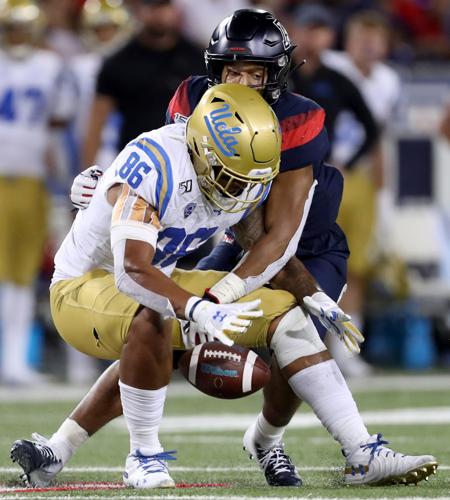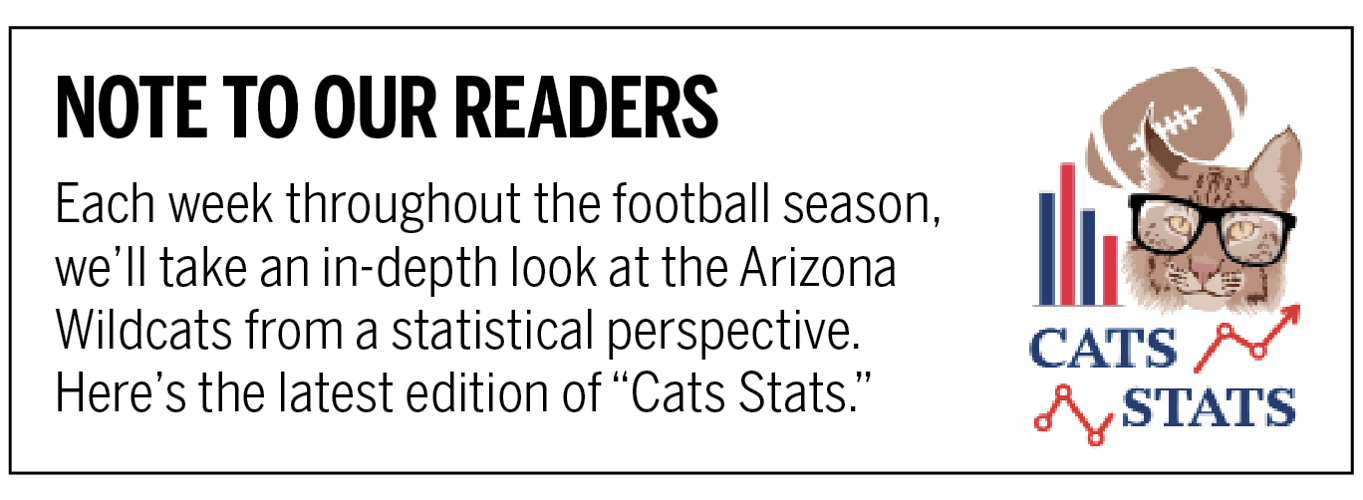
Every football player does it. When the third quarter ends and the fourth is about to begin, they hold up four fingers to reinforce the importance of the final period.
It’s not as if the first three quarters are any less significant. But we’ve all experienced the #Pac12AfterDark phenomenon. We know how things go in this conference. Oftentimes, games come down to the very end.
Last year, eight teams in the Pac-12 had an average scoring margin of less than seven points, per TeamRankings.com. The Arizona Wildcats were one of them. Six of their games were decided by one score (eight points) or less. They went 2-4 in those games.
They didn’t all feature fourth-quarter lead changes or wild swings of emotion and momentum. The past two fourth quarters did. And Arizona owned them.
In today’s edition of “Cats Stats,” we’ll examine some of the factors behind the Wildcats’ 22-0 advantage in the past two fourth quarters. We’ll also try to put that achievement in some perspective.
Let’s start with this easy-to-forget fact: Arizona trailed entering the fourth quarter against Texas Tech and UCLA. The Red Raiders’ 14-13 lead didn’t last long into the fourth; Gary Brightwell scored on the first play of the period. Brightwell also provided the go-ahead points against the Bruins, scoring 4:09 into the fourth last Saturday.
Before the Texas Tech game, the Wildcats had lost 25 straight games when trailing after three quarters. That streak dated to Oct. 17, 2015, when Arizona rallied from a 24-17 deficit to defeat Colorado 38-31 in Boulder. The Wildcats visit the Buffaloes this Saturday.
Of all the one-score games from last season, the Colorado contest most closely resembled Arizona’s past two games. The Wildcats led 35-34 entering the fourth quarter, CU having trimmed its deficit to a point on a field goal on the final play of the third. Arizona expanded its lead to eight on Khalil Tate’s 57-yard touchdown pass to Cedric Peterson with 13:04 remaining. The Wildcats held on from there.
Obviously, a lot of factors contribute to the outcome of a football game. Arizona made key third-down conversions and critical defensive stops in the fourth quarter against Colorado last year and against Texas Tech and UCLA this year.
Looking for a purely statistical common thread led us to an unexpected place.
In all three games, the Wildcats dominated time of possession in the fourth quarter. Whether they scored or not, they kept and moved the ball.
Against Colorado, Arizona had a possession-time edge of 3 minutes, 2 seconds. Against Texas Tech, it was 3:48. Against UCLA: 3:22.
The Wildcats’ longest drive in each game by time of possession happened in the fourth quarter. That might seem like a no-brainer given that teams often slow the tempo to protect leads in the final period. But Arizona deserves credit for executing in those situations. And shouldn’t that be the overarching goal – to keep the ball as long as possible and minimize the time the other team has it?
The time-of-possession theory is undermined by the 2018 finale. The UA had a possession-time advantage of 2:52 in the fourth quarter against Arizona State — yet was still outscored 20-0. Those two figures — which are seemingly at odds — prompt a closer look at that particular period. (Sorry to go there, Wildcat fans, but this is important stuff).
The fourth quarter against ASU was a master class in how not to manage the final 15 minutes of a game. The Wildcats became too conservative on offense, then turned the ball over two times on their side of the field. A 40-21 lead turned into a 41-40 defeat.
Arizona actually ran more plays (25) than ASU (17) in the final period. The Wildcats’ 25 offensive snaps netted just 74 yards, or 2.96 per play. In the first three quarters, they averaged 7.69 per play.
Each turnover set up the Sun Devils at the UA 22-yard line. ASU’s average starting field position in the fourth quarter was the 50. In the first three quarters, it was the ASU 23.
Junior safety Scottie Young Jr. was asked whether the fourth-quarter trauma from the ASU game had any influence on the fourth-quarter excellence of the past two games. He initially balked at that theory.
“What was done in the past is over with,” Young said. “We learn from it, but we let that go.”
He then came around to the idea.
“We told ourselves we would never let that happen again,” Young said. “That’s been our thing. Just play four quarters, and we’ll finish games.”

Arizona safety Scottie Young Jr. (6) pops the ball out of the hands UCLA tight end Devin Asiasi (86) printing him from making the catch in their Pac-12 football game at Arizona Stadium, Tucson, Sept. 28, 2019.
The coaching staff certainly seemed to learn a lesson from ASU. A spate of run plays — eight in a row, to be exact — sapped Arizona’s energy during that fourth-quarter meltdown.
While protecting a three-point lead against UCLA, Kevin Sumlin and Noel Mazzone faced a difficult choice. Arizona needed to convert on third-and-9 from its 7-yard line with a little over 6 minutes to play. If the Wildcats had run the ball and punted, it would have been understandable. After all, they had a true freshman playing quarterback.
But Sumlin and Mazzone trusted their players. Grant Gunnell completed a back-shoulder throw to Bam Smith, who made a twisting grab just inside the left sideline for 21 yards and a first down. Arizona eventually had to punt but gained about 40 yards in field position. UCLA started from its 9 with 2:52 to play. The Bruins’ average starting field position in the fourth was their 17. Texas Tech’s was its own 24.
Despite being outscored 34-0 in the fourth quarter of the final two games last season — including 14-0 at Washington State — Arizona actually had an overall advantage in the final period of 100-86. Context is critical here, though: The UA outscored BYU and USC 26-0 in the fourth. That’s obviously good, but the Wildcats trailed by 18 and 17 points, respectively, entering the final period and lost both games.
Something looked and felt different about Arizona in the fourth quarter in the past two games. Players cited two factors that aren’t easily quantifiable.
One is the work of Brian Johnson, the UA’s director of strength and conditioning for football. Remember when multiple Wildcats cramped up at Houston last year? Now, it’s players on the other side who’ve had to tap out.
“They started getting up slower, they start moving slower,” Young said. “They’re running a little more timid across the middle. That kind of gives us an edge.”
Arizona also has developed and committed to a real rotation along the defensive line. Eight D-linemen played between 21 and 55 snaps against UCLA, per Pro Football Focus.
“When you get out there,” defensive tackle Finton Connolly said, “you make the most of it.”
Two fourth-quarter shutouts — and two wins — later, Connolly and the Wildcats most certainly have.







